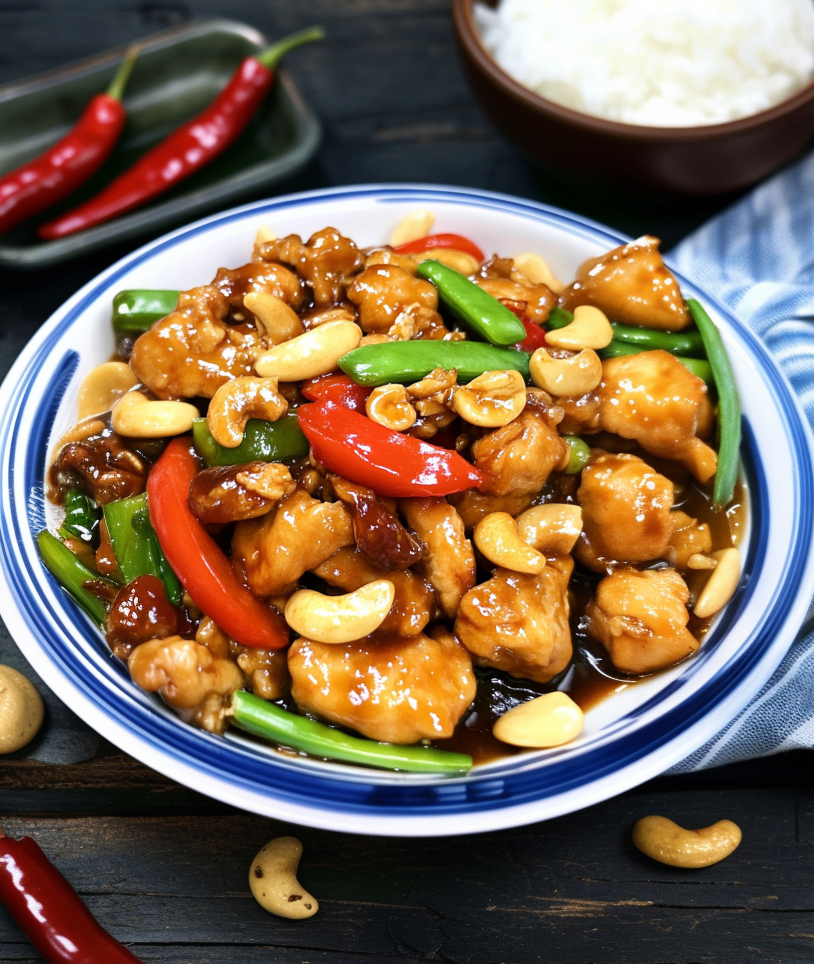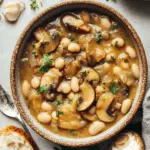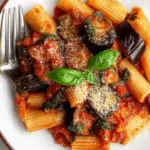Thai Cashew Chicken is a vibrant and flavorful stir-fry that brings together tender chicken pieces, crunchy roasted cashews, and a medley of colorful vegetables, all tossed in a savory and slightly sweet sauce. This dish is a popular choice for those seeking a quick yet satisfying meal that doesn’t compromise on taste. With its combination of textures and bold flavors, Thai Cashew Chicken is sure to become a favorite in your dinner rotation.
Full Recipe:
Ingredients:
- 1.5 lbs boneless, skinless chicken thighs or breasts, cut into bite-sized pieces
- 2 tablespoons cornstarch
- ½ teaspoon salt
- ½ teaspoon pepper
- 2 tablespoons cooking oil
- 1 cup roasted cashews
- 1 medium onion, diced
- 1 red bell pepper, diced
- 1 green bell pepper, diced
- 3 cloves garlic, minced
- 3-4 dried red chilies or Thai bird’s eye chilies, roughly chopped
- 2 scallions, chopped (separate white and green parts)
For the Sauce:
- 2 tablespoons oyster sauce
- 1 tablespoon fish sauce
- 1 tablespoon soy sauce
- 1 tablespoon dark soy sauce
- 1 tablespoon sugar
- 1 teaspoon cornstarch
- 1 tablespoon rice vinegar
- 2 tablespoons water
Directions:
- In a bowl, toss the chicken pieces with cornstarch, salt, and pepper until evenly coated.
- Heat the cooking oil in a wok or large skillet over medium-high heat. Add the chicken and sauté until it’s just cooked through. Remove and set aside.
- In the same wok, add the minced garlic and chopped dried chilies. Stir-fry for about 30 seconds until fragrant.
- Add the diced onion, red and green bell peppers, and the white parts of the scallions. Stir-fry for 2-3 minutes until the vegetables are slightly tender.
- Return the cooked chicken to the wok and add the roasted cashews. Mix well.
- In a small bowl, whisk together all the sauce ingredients until smooth. Pour the sauce over the chicken and vegetables in the wok. Stir-fry for another 2-3 minutes until everything is well-coated and the sauce has thickened.
- Add the green parts of the scallions, give a final stir, and remove from heat.
- Serve hot over steamed rice or noodles.
Nutritional Information (per serving):
- Calories: 450 kcal
- Total Fat: 25g
- Saturated Fat: 5g
- Cholesterol: 90mg
- Sodium: 800mg
- Total Carbohydrates: 20g
- Dietary Fiber: 3g
- Sugars: 5g
- Protein: 35g
Cultural and Culinary Background
Thai cuisine is renowned worldwide for its intricate balance of flavors and textures, with an emphasis on fresh ingredients and aromatic herbs and spices. Thai Cashew Chicken, or “Gai Pad Med Mamuang,” is a classic example of how everyday ingredients can be transformed into an extraordinary dish with the right technique and seasoning. The use of cashews in this recipe reflects a broader tradition within Thai cooking of incorporating nuts to add richness and texture.
The dish is a fusion of influences from Thai, Chinese, and Southeast Asian culinary traditions. Stir-frying—a common cooking method—ensures that the chicken remains tender while the vegetables retain their crunch. The sauce, which often includes elements such as oyster sauce, soy sauce, and fish sauce, provides a perfect umami base that is both savory and slightly sweet. This combination is indicative of Thai cuisine’s ability to layer flavors in a way that delights the palate.
Flavor Profile and Ingredients Impact
The hallmark of Thai Cashew Chicken is its perfectly balanced flavor profile. The sauce combines salty, sweet, and umami notes with a subtle hint of acidity. Oyster sauce adds a deep savory richness, while fish sauce contributes the quintessential Thai pungency that enhances the dish’s complexity without overwhelming it. Soy sauces—both regular and dark—offer salty depth and a slight sweetness. The sugar balances the saltiness and adds a caramelized touch.
Garlic and dried chilies add aromatic warmth and a mild heat, which can be adjusted to suit personal taste preferences. The inclusion of fresh vegetables like bell peppers and onions introduces a natural sweetness and crisp texture that contrasts beautifully with the tender chicken and crunchy cashews.
Cashews play a crucial role beyond texture—they impart a creamy, buttery flavor that complements the savory elements and enriches the overall taste experience. Additionally, the nuts provide healthy fats and protein, elevating the nutritional value of the dish.
Nutritional Benefits
Thai Cashew Chicken is a well-rounded meal that offers a good balance of macronutrients. Chicken is a lean source of protein, essential for muscle maintenance, immune function, and overall health. The presence of cashews contributes healthy monounsaturated fats, which support heart health by helping to lower bad cholesterol levels.
The dish also provides a moderate amount of carbohydrates primarily from the vegetables and the sugars in the sauce. The fiber content from the vegetables and cashews aids in digestion and helps maintain blood sugar levels, making this meal suitable for those seeking balanced nutrition.
However, it’s important to be mindful of the sodium content, which can be relatively high due to the soy sauce, oyster sauce, and fish sauce. Individuals monitoring their salt intake should consider using reduced-sodium versions of these ingredients or adjusting the quantities to keep the dish heart-healthy.
Versatility and Serving Suggestions
One of the strengths of Thai Cashew Chicken is its versatility. It can be served over steamed jasmine rice for a traditional meal or paired with noodles for a satisfying alternative. It also works well in lettuce wraps, providing a fresh and crunchy contrast that lightens the dish.
The recipe can be customized to accommodate various dietary preferences. For example, substituting chicken with tofu or shrimp offers options for vegetarians or seafood lovers. To make it spicier, additional fresh chilies or chili flakes can be incorporated, while those sensitive to heat can reduce or omit them altogether.
Accompanying the dish with a fresh Thai cucumber salad or a simple side of stir-fried greens adds a refreshing element and balances the meal nutritionally. Garnishing with fresh cilantro or lime wedges enhances the aroma and adds a zesty finish.
Cooking Techniques and Tips
Mastering the stir-fry technique is key to achieving the ideal texture and flavor in Thai Cashew Chicken. Cooking over high heat ensures that the chicken cooks quickly without drying out, while the vegetables retain their crunch and vibrant color. Tossing the chicken with cornstarch before cooking helps to lock in moisture and gives the chicken a slight crispness.
Roasting the cashews separately intensifies their nutty flavor and provides a satisfying crunch that contrasts with the softness of the cooked ingredients. It is important to watch the cashews closely when roasting to avoid burning, which can impart a bitter taste.
Balancing the sauce by adjusting the amount of sugar, salt, and acidity can help tailor the dish to your personal taste. Preparing the sauce mixture in advance streamlines the cooking process, allowing for quick assembly once the ingredients are ready.
Health Considerations
While Thai Cashew Chicken is flavorful and nourishing, some ingredients can be a concern for certain dietary needs. Fish sauce and soy sauce contribute sodium, which may require moderation for those with hypertension or heart conditions. Additionally, cashews, while healthy, are calorie-dense and should be eaten in moderation as part of a balanced diet.
Gluten-sensitive individuals can use tamari or gluten-free soy sauce as substitutes. For those avoiding animal products, vegan oyster sauce alternatives are available, allowing the recipe to be made fully plant-based.
Popularity and Global Appeal
Thai Cashew Chicken enjoys worldwide popularity not only because of its delicious taste but also due to its approachable preparation. It strikes a perfect balance between exotic flavors and familiarity, appealing to both newcomers to Thai cuisine and seasoned fans.
Its global appeal has led to countless variations in home kitchens and restaurants, adapting local ingredients and tastes while maintaining the essence of the dish. The combination of accessible ingredients and bold flavors makes it a favorite for cooking enthusiasts who want to bring a taste of Thailand into their homes.
Conclusion
Thai Cashew Chicken is a wonderful dish that beautifully encapsulates the vibrant, balanced flavors of Thai cuisine. Its harmonious blend of tender chicken, crunchy cashews, fresh vegetables, and rich, savory sauce creates a satisfying and nutritious meal that is both simple to prepare and impressive to serve.






